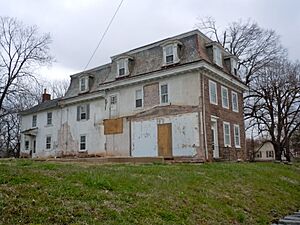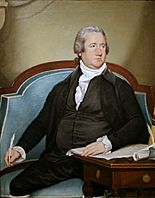The Speaker's House facts for kids
The Speaker's House is a museum in Trappe, Pennsylvania. It's in Montgomery County, Pennsylvania. This museum keeps alive the home of Frederick Muhlenberg. He was the very first and third Speaker of the United States House of Representatives. The house was built in 1763. Muhlenberg bought it in 1781. His family lived there until 1791.
Contents
History of The Speaker's House
Early Settlers in Trappe (1717–1781)
The first settlers in Trappe were German immigrants. John Jacob Schrack and his wife Eva Rosina Lang Schrack arrived in 1717. They had seven children. John Jacob Schrack Sr. was important to the community. He ran a tavern called "the Trap." This is how the town of Trappe got its name.
In 1742, a Lutheran pastor named Henry Melchior Muhlenberg came to Trappe. John, the Schracks' oldest son, took over the tavern. He and his wife Silence built the house in 1763. This is the house now known as The Speaker's House. After John died in 1772, Silence sold the house.
The house changed hands several times. James Diemer bought it in 1772. Then Michael Connor, a merchant, bought it in 1775. Henry Muhlenberg described the Connors as his neighbors. In 1777, John Patton, a colonel in the Continental Army, purchased the house. He lived there with his family.
In 1778, Isaac Connely bought the house. Just 22 days later, he sold it to John Reed. Reed was an innkeeper and a neighbor. Henry Melchior Muhlenberg bought supplies from him. In December 1781, Reed sold the house to Frederick Muhlenberg.
Frederick Muhlenberg's Time (1781–1791)
Frederick Muhlenberg was born in Trappe in 1750. He was one of eleven children. His father, Henry Melchior Muhlenberg, led the German Lutheran Church in America. Frederick studied in Germany. He became a Lutheran minister in 1770. The next year, he married Catharine Schaeffer. They had seven children.
Frederick left the ministry in 1779 to enter politics. He joined the Continental Congress. The next year, he became Speaker of the Pennsylvania Assembly. In December 1781, Frederick bought the stone house in Trappe. It cost £800. The house was next to his parents' home. It helped support his family when he was away.
Frederick's political career grew. In 1783, he led the Council of Censors for Philadelphia County. When Montgomery County started in 1784, he became its first Register of Wills. His Trappe home was both his family home and a government office. There was no official courthouse yet. Frederick also ran a general store on the property. He sold items like sugar, tea, and fabric.
In 1787, Frederick led the Pennsylvania Constitutional Convention. The next year, he was elected to the First United States Congress. In 1789, he became the first Speaker of the House. This important job meant he hosted many events. He earned twice as much as other congressmen. Frederick Muhlenberg was the first person to sign the Bill of Rights.
The federal government moved from New York to Philadelphia in 1790. Frederick then sold his Trappe property. He moved his family to Philadelphia. He continued his political work. He was elected Speaker again during the Third Congress.
In 1796, Frederick Muhlenberg made a tough decision. He voted to approve funds for the Jay Treaty with Great Britain. This vote ended his political career. It also led to a dangerous incident with his brother-in-law. In 1799, he became Receiver General of the Pennsylvania Land Office. He moved to Lancaster, the state capital then. He passed away in 1801.
After Frederick Muhlenberg (1791-1900s)
Frederick Muhlenberg sold the house in 1791. His sister Mary and her husband Francis Swaine bought it. The Swaines may have lived there before buying it.
Records from 1798 show the house was valued at $800. The property was worth $1,380. The stone house was two stories tall. It measured 30 by 25 feet. There were also four other stone buildings. These included a kitchen, a store room, a store, and a barn.
In 1799, Peter Muhlenberg wrote that the Swaines lived in the house. He noted that Francis Swaine ran a store. He was also a local judge. The Swaines sold the house in 1803. Charles Albrecht, a pianomaker, bought it. He lived there for several years.
In 1808, Abraham Gotwals bought the house. He and his family lived in Upper Providence Township. They sold the property in 1811 to Sarah Bartleson. She was married to Dr. William Johnson. The Johnson family lived in the house. A neighbor remembered a small store attached to the house. It sold watermelons and other goods.
After Dr. Johnson died in 1831, his wife Sarah managed the property. When Sarah died, the property was divided. Enos Lewis bought the part with the house in 1841. He later bought the other part too. In 1855, Enos and Margaret Lewis sold the house to Samuel Townsend.
Samuel Townsend passed away in 1860. Henry Shuler bought the house. After Shuler died in 1864, Dr. Lewis Royer purchased it in 1867. He updated the house. He removed the old store and added a new section. He sold the house in 1884 but bought it back in 1890. He owned it until his death in 1908.
20th Century Changes
Andrew Heyser Detwiler bought the property in 1908. In 1924, he sold it to brothers Henry and Percy Mathieu. They sold it just four weeks later to Ursinus College. The college bought the house to help with student housing.
The house was renamed "Highland Hall." It was renovated for 26 to 28 male students. New bathrooms and closets were added. A steam heating system was installed. In 1925, it became the Ursinus College Athletic Club. It housed male varsity players. From about 1931 to 1937, the college's athletic director, Russell "Jing" Johnson, lived there.
In 1933, Ursinus College made more changes. They removed the front porch. They added a flagstone terrace. A new roof style was also installed. By 1942, the house was used as a women's residence hall. In 1944, Ursinus sold the house to Andrew and Myrtle Rihl. The college had already sold much of the land to the local school district in 1938.
In 1950, the Riehls sold the house to Henry L. Haas and his wife Anna. Later, Henry remarried Lenore. By the 1960s, the Haases rented out the second and third floors as apartments. They lived on the first floor.
Saving The Speaker's House
In 1999, a company wanted to buy the property. They planned to tear down the house and build a drugstore. Local residents worked together to save it. In 2001, they started a non-profit group called Save the Speaker's House, Inc.
This group bought the property on April 1, 2004. In 2005, they received a grant. This money helped them research the house. They created a report about its condition. They used tree-ring analysis to learn more. This showed the house was built in 1763. John Schrack owned it then.
Archaeological digs started in 2006. The property became the first official state archaeological site in Trappe. They found the foundation of Frederick Muhlenberg's general store. It was attached to the east side of the house.
In 2006, the organization paid off its mortgage. This was thanks to a grant. The property is now protected as open space forever. To celebrate, the group changed its name to The Speaker's House. In 2008, a historical marker was placed there. It honors Frederick Muhlenberg's life.
The Speaker's House aims to inspire leadership. It teaches about Frederick Muhlenberg's home and his important work.
Important Portraits
The job of Speaker of the U.S. House of Representatives was created by the U.S. Constitution. Frederick Muhlenberg was part of the First U.S. Congress. He was elected the first Speaker on April 1, 1789. New York City was the first capital of the United States. Philadelphia became the second capital from 1790 to 1800.
Muhlenberg asked artist Joseph Wright to paint his portrait. The painting shows Muhlenberg in the Speaker's chair. He is at Federal Hall in New York City. He holds a quill pen. He is signing a bill about trade with Native American tribes. Wright likely painted this in New York City. It is the only known image of Frederick Muhlenberg from his lifetime. It is also the only known image of the inside of Federal Hall.
Muhlenberg also asked Wright to paint his wife, Catharine Schaeffer Muhlenberg. These two portraits stayed in the Muhlenberg family for many years. In 1974, the National Portrait Gallery bought Frederick's portrait.
For a long time, people thought Catharine Muhlenberg's portrait was lost. It had not been seen since 1910. However, in 2016, her descendants found it. It was in the attic of a house in Newport, Rhode Island. The family has now loaned the portrait to The Speaker's House.
The Speaker's House also owns a copy of Frederick Muhlenberg's portrait. It was painted in the 1800s. It is believed to be by artist Jacob Eichholtz. A Muhlenberg family member donated it to the museum in 2007.




